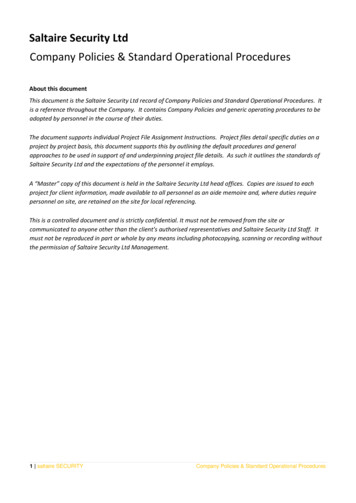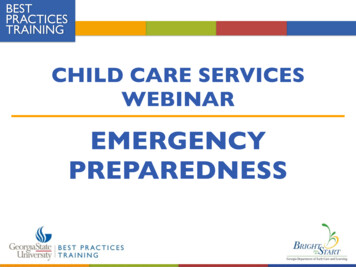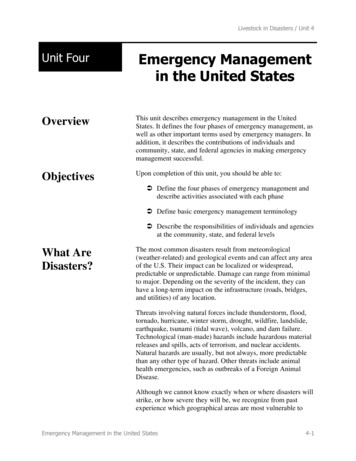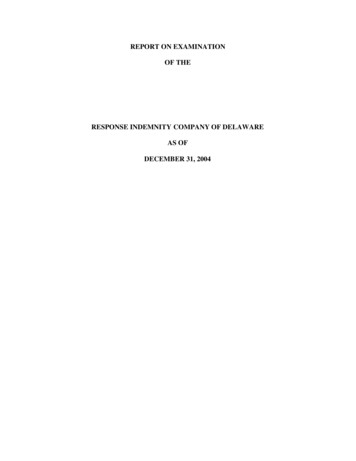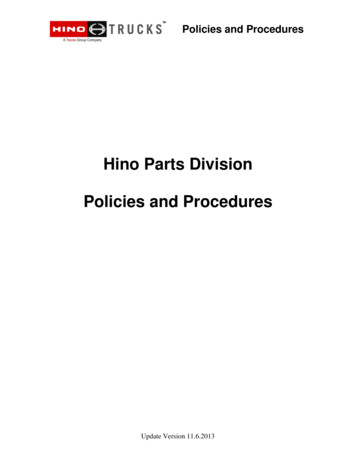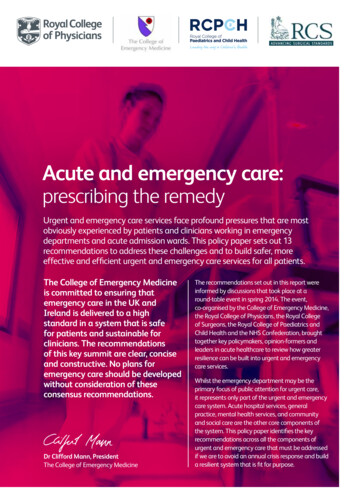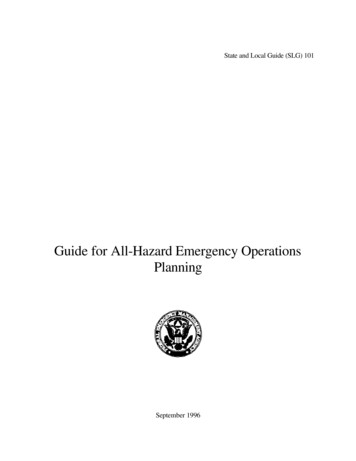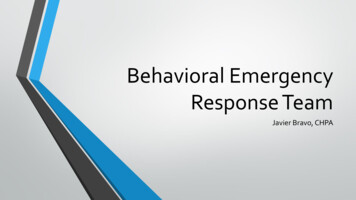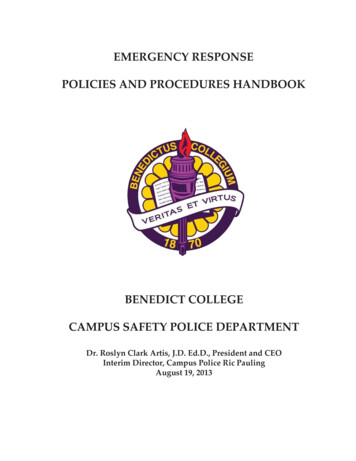
Transcription
EMERGENCY RESPONSEPOLICIES AND PROCEDURES HANDBOOKBENEDICT COLLEGECAMPUS SAFETY POLICE DEPARTMENTDr. Roslyn Clark Artis, J.D. Ed.D., President and CEOInterim Director, Campus Police Ric PaulingAugust 19, 2013
DISASTER MANAGEMENT PLANBENEDICT COLLEGEWhen calling, stay calm and carefully explain the problem and location tothe Campus Police Dispatcher.DO NOT HANG UP UNTIL TOLD TO DO SOIMPORTANT TELEPHONE NUMBERSCampus Police Department . 705-6455Other Emergency Responders (Fire/Police/Ambulance 9-1-1
TABLE OF CONTENTSPurpose.1Scope .1Definitions.1Assumptions.1Declaring A Campus State of Emergency .2PROCEDURES.2EVACUATIONS .3EMERGENCY RESPONSE POLICIES AND PROCEDURES .4Section IFires.4Fire Evacuation Procedures .5Section IIBomb Threats .6The Search .7Evacuation.7Section IIIHurricanes/Flooding .8Physical Plant Hurricane Preparation Plan .9Disaster Management Plan .11Purpose.11Organization .11Situation .11Mission.11Execution .12
TABLE OF CONTENTS CONT’DDirection and Control .13College Administration .13SPECIAL NEEDS SHELTER .16County Situation Report for EOC Sheet .17TORNADOES .18American Red Cross Contact Information Sheet .19City Emergency Information Sheet .20EARTHQUAKES .21UTILITY FAILURE .23EXPLOSIONS .24CHEMICAL OR RADIATION SPILL .25ADDITIONAL INFORMATION AND PROCEDURES.26Computer Equipment .26Elevator Failure.26Plumbing Failure/Flooding .26Gas Leak .26Steam Line Failure .26Ventilation Problem .26VIOLENT OR CRIMINAL BEHAVIOR .27CIVIL DISTURBANCE OR DEMONSTRATION .28PSYCHOLOGICAL CRISIS .28MEDICAL AND FIRST AID.29TWENTY-FOUR (24) HOUR ALERT .30CURFEW .30DEATHS .31
PURPOSE:The purpose of this Emergency Response Policies and Procedures Handbook is toinform students, faculty/staff and administrators of the hazards involved in emergencies.Listed are the correct procedures, which must be followed to minimize any danger.SCOPE:These procedures are designed to be flexible in order to accommodatecontingencies of various types. These procedures apply to all college personnel and allbuildings and grounds owned, operated and maintained by the college.DEFINITIONS:The college President or Chief of Campus Police serves as the overall EmergencyDirector during any major emergency or disaster. The following definitions areguidelines to assist the college in determining the appropriate response:A. MINOR EMERGENCY- A minor emergency is any incident or potential incidentwhich would not seriously affect the college’s ability to conduct “business as usual.”B. MAJOR EMERGENCY- A major emergency is any incident or potential incidentwhich affects an entire building or buildings, or which disrupts the college’s ability todo “business as usual.” Outside emergency services will probably be required, aswell as major efforts from campus support services. Major policy considerations anddecisions will usually be required from the college administration during times ofcrisis.C. DISASTER- A disaster is any event or occurrence which seriously impairs thecollege’s ability to do “business as usual.” In some cases, this might involve masspersonnel casualties and severe property damage. The coordinated effort of allcampus-wide resources is required to effectively control the situation. An EmergencyControl Center will be activated, and decisions will be made about the appropriatesupport. Operational plans will be made as soon as possible.ASSUMPTIONS:The College Emergency Response Policies and Procedures Handbook ispredicated on a realistic approach to the problems likely to be encountered on campusduring a major emergency or disaster. The following are general guidelines:a. An emergency or disaster may occur at any time of the day or night, weekend orholiday, with little or no warning.b. The succession of events in an emergency is not predictable. Published support andoperational plans will serve only as a guide and a checklist, which may requiremodification in order to meet the specific requirements of the emergency.c. Disasters may affect residents in the geographical location of the college, so City,County and Federal emergency services may be required of the emergency.
DECLARING A CAMPUS STATE OF EMERGENCY:The authority to declare a campus state of emergency rests with the collegePresident or his/her designee as follows:a. The Campus Police Director shall immediately consult with the President or his/herdesignee regarding the emergency and determine whether or not a campus-wide stateof emergency exists. During the period of any major campus emergency the CampusPolice Department will immediately put into effect the appropriate proceduresnecessary in order to meet the emergency, safeguard people and property, andmaintain educational facilities.b. When it is determined that a campus-wide state of emergency exists, only registeredstudents, faculty, staff and affiliates (i.e., persons required by employment) areauthorized to be on the Campus. Those who cannot present proper identificationshowing their legitimate business on campus will be required to leave immediately.c. In addition, only those faculty and staff members who have been assigned emergencyresource team duties or issued an emergency pass by the Campus Police Departmentwill be allowed to enter the immediate disaster site.d. In the event of earthquakes, after shocks, fires, storms, or major disasters occurring inor about the campus, or which involve college property, Campus Police Officers willbe dispatched to determine the extent of any damage to college property.PROCEDURES:This section outlines the procedures to be followed during specific types ofemergencies. The procedures should always be followed in sequence, unlessconditions dictate otherwise.When reporting emergencies, immediately notify the Campus Police Departmentat ext. 5400 or call 9-1-1. While talking on the telephone, stay calm and carefully explainthe problem and location to the Campus Police Officer or Dispatcher. DO NOT HANGUP UNTIL TOLD TO DO SO.NOTE: The Campus Police Officer or Dispatcher will immediately report the incidentto the Director of the Campus Police Department who will in turn, immediately notifythe President and Vice Presidents.
EVACUATIONSBuilding Evacuations:a. All building evacuations will occur upon notification by the Campus PoliceDepartment or the Community Life Counselors in the Residence Halls.b. When the building evacuation alarm is announced, leave by the nearest exit and alertothers to do the same.c. ASSIST THE HANDICAPPED IN EXITING THE BUILDING. Remember thatelevators are reserved for handicapped persons. DO NOT USE THE ELEVATORSIF THERE IS RISK OF FIRE.d. Once outside, proceed to a clear area that is at least 500 feet away from the affectedbuilding. Keep street, fire lanes, hydrant areas and walkways clear for emergencyvehicles and personnel. Know your assembly points. Familiarize yourself withevacuation plans posted in your building.e. DO NOT return to an evacuated building unless told to do so by a member of theCampus Police Department.IMPORTANT: After any evacuation, report to your designated area assembly point.Stay there until an accurate headcount is taken.Campus Evacuation:a. Evacuation of all or part of the Campus grounds will be announced by the CampusPolice Department.b. All persons (students, faculty and staff) are to immediately vacate the site in questionand relocate to another part of the campus grounds as directed.Media RelationsThe college has three guidelines to observe in crisis situations:a. Only an authorized college spokesperson will meet or speak with the media on behalfof the college.b. Only factual information is released.c. The President and other senior administrators will develop an institutional response tobe released to the media, including periodic media updates.
EMERGENCY RESPONSE POLICIES AND PROCEDURESSECTION IFIRES:A fire is the most likely disaster that may affect the Campus of Benedict Collegeand it is perhaps the most deadly one. The following measures should be reviewed andutilized in the event there is a fire at any location on campus.There are basically two types of fires: Minor fires, which can be extinguishedwith a fire extinguisher, and major fires, which require assistance from the Columbia FireDepartment. Both however, call for calm, immediate action by the person discoveringthe fire.If you smell smoke or have any other indication of fire:a. Immediately contact the Campus Police Department at ext. 5400. Describe what youhave observed and give your name and exact location.b. Alert other building occupants in the immediate area to prepare for evacuation andassist the handicapped in exiting the building.c. Wait outside the building for the arrival of Campus Police Officer(s) and/or theColumbia Fire Department. Be prepared to provide additional information and yourobservations to responding personnel.If flames are observed:a. Upon discovery of a small fire, activate the nearest fire alarm. Proceed to the nearestfire extinguisher, which in most cases, is located near the fire alarm; then follow thebasic operational directions to utilize the extinguisher. Contact the Fire Departmentat 9-1-1.b. If the fire gets out of control or you judge the fire to be too large to attempt toextinguish single-handedly, call for help immediately and leave the area.c. Immediately evacuate the building and go to the nearest phone. Call 911 and reportthe fire, giving information as requested by the operator (0) dispatcher. Stay on theline until released by the operator/dispatcher.d. After alerting the operator, call the Campus Police Department at ext. 5400 and givethe fire location to the officer/dispatcher. Stay on the line until you are released bythe officer/dispatcher.
Fire Evacuation ProceduresIf you hear an alarm sound:a. Evacuate the building immediately and assist the handicapped in exiting the building.b. If smoke is present, keep low to the floor.c. Before opening the door, feel the upper portion of the door. If the upper door ordoorknob is hot, DO NOT OPEN THE DOOR.d. If the door or the doorknob is not hot, brace yourself against the door and open itslightly.e. If heat or heavy smoke is encountered in the corridor, close the door and stay in theroom.f. Keep the door closed, and if your windows are the type that can be raised or lowered,open the top slightly to let out the heat and smoke, open the bottom slightly to let infresh air.g. Seal the cracks around the door with clothing, tape or other material, soaking it inwater if available.h. Hang an object out the window, such as a shirt, jacket, towel or anything that willattract attention.i. If you can leave the room, close all doors behind you as you move to the nearest exitor stairway. This will retard the spread of smoke and fire and lessen damage.DO NOT USE ELEVATORS!!!j. If the nearest exit is blocked, go to an alternate exit. If all exits are blocked, go to aroom furthest from the fire, close the door and follow procedures described in Fthrough H.k. After leaving the building, DO NOT RE-ENTER. Stay clear of respondingemergency equipment and personnel.l. DO NOT attempt to return to the structure to retrieve any items until the building iscleared by College Officials or the Fire Department.In the event that Arson is suspected, the Columbia Fire Department (CFD) should becontacted immediately. The area should be protected until CFD arrives.
SECTION IIBOMB THREATBomb threats occur quite often. In rare instances, actual explosives are placed inthe structure. Because of the hazards involved in such situations, it is necessary todevelop a Bomb Threat Policy for the Campus of Benedict College. The purpose of thisplan is to: Ensure the safety of occupants of the structure;Minimize anxiety and panicMinimize disruption of regular activities; andProtect the Benedict College family and propertyWhen a bomb threat is received, the individual taking the call should be instructedin advance to:a. Stay calm. Make a note of the date and time.b. Try to keep the caller talking as long as possible. The more he/she talks, the moreyou may learn.c. Try to record everything the caller says, if possible.d. The following questions should be asked, as well as others deemed appropriate by theindividual receiving the call:1. There are many people in this building and we do not want anyone hurt.When is the bomb going to explode?2. Exactly where is the bomb located?3. What does the bomb look like?4. What kind of bomb is it?5. What will cause the bomb to explode?6. Did you place the bomb?7. Why?8. What is your address? (Usually the caller will not answer, but it does not hurtto ask).9. What is your name?e. Listen closely to the voice of the caller and note the following: Sex of the caller; Age of the caller; Race of the caller; Accent (is the voice native to the area?) Speech impediments or peculiar voice characteristics (i.e., drunk, lisp, etc,); and Attitude of caller (i.e., calm, excited, etc,).f. Pay particular attention to any strange or peculiar background noises such as streetnoise, motor noise, music, television or radio programs, dishes rattling, baby crying,or other background noise that might offer a remote clue as to the origin of the call.g. Once the caller hangs up immediately contact the Director of Campus Police.
The SearchThe quickest and most effective search of a structure can be done bythe regular occupants of the building. Since bombs come in many forms, itis very difficult for police or anyone not familiar with the building toidentify any object as being new or suspicious. Each individual shouldquickly inspect his/her area (i.e., dormitory room, an office or a classroom).Anything found that arouses suspicion should not be moved or touched. Anote should be made as to the description of the object and its exact location.This should be promptly reported to the authorities.EvacuationThe order to evacuate a structure can be given by anyone who locatesa suspicious object. The Fire Alarm may be utilized as a means of alertingoccupants of an evacuation. Handicapped individuals should be assisted inexiting the building. DO NOT use elevators in the event of a fire. DO NOTPANIC. Fire escape routes may be utilized in order to evacuate the structurein an orderly manner. If a suspicious object is found near an escape route,the evacuation should be rerouted as necessary. All doors should be leftopen when leaving the area. Occupants of the threatened structure shouldmove as far away from the structure as possible. In case of inclementweather, occupants may possibly take refuge in other structures that are asafe distance away. However no automobiles are to be moved during thethreat. No one will be able to re-enter the building until the clear messagehas been delivered by the Director of Campus Police or his designee. Theseare the only individuals with the authority to issue this order.
SECTION IIIHURRICANES/FLOODINGOfficially, hurricane season begins in June and ends in November, but HurricaneWatches and Warnings can be issued at any time during the year for the followingreasons: A Hurricane Watch is issued whenever a Hurricane becomes a threat to coastalareas. Everyone in the area covered by the watch should listen (weather bandradios and local radio stations) for further advisories and be prepared to actpromptly if a Hurricane Warning is issued. A Hurricane Warning is issued when hurricane winds of seventy-four (74) milesan hour or higher, or a combination of dangerously high water and very roughseas are expected in a specific coastal area within a twenty-four (24) hour period.The following precautionary measures should be taken immediately.a. Keep a battery-operated radio tuned to a local station, and follow the instructions.Remain calm. If you are told to evacuate, move out of the structure to designatedhigh groundb. Turn off all utilities. DO NOT touch any electrical equipment unless it is in a dryarea. Avoid the use of telephones.c. Avoid travel in automobiles. Roads may be washed away by the floodwaters andrapidly rising water levels could carry the vehicle away.d. If you are trapped in a structure by rapidly rising floodwater, move to the top floor orthe roof of the structure. DO NOT attempt to swim to safety. Wait for help.e. DO NOT be fooled by the “eye” of the hurricane. If the storm center passes directlyoverhead, there will be a lull in the winds lasting from a few minutes to half an houror more. At the side of the “eyes,” the winds will increase rapidly to hurricane forceand will come from the opposite direction.f. Once the hurricane has passed, remain inside until informed by authorities that it issafe to leave. Assist the handicapped in exiting the building.g. Keep your radio tuned to a local station for updates on the situation and vitalinformation.h. Stay out of disaster areas. Sightseeing interferes with essential rescue and recoverywork and may be dangerous as well.i. Avoid loose or dangling wires, and report them immediately to the authorities.j. Make a conscious effort to prevent fires. Decrease water pressure may makefirefighting difficult.NOTE: The probability of Tornadoes spawned by Hurricanes is very high. When ahurricane approaches, listen for Tornado Watches and Warnings, and be ready to takeimmediate action.
Physical Plant Hurricane Preparation PlanThis plan is designed to provide a list tasks and duties that should be accomplished by thePhysical Plant in the event a Hurricane Warning OPCON 4, is issued for the Columbiaarea.96 to 120 hours prior:1. Close monitoring of storm for arrival time and location.2. Check supplies for building preparation/repair/recovery for all shops3. Order and stock supplies that are high priority, high demand or long lead timeA. PlywoodI. TapeB. GasolineJ. Rope and ChainC. DieselK. Electrical SuppliesD. 2x4’s, 2x6’sL. Nails, ScrewsE. Roll PlasticM. GlovesF. BatteriesN. Hand ToolsG. Foul Weather GearO. Chain SawsH. Flash Light4. Check availability of rental generators-150 and 100 KVA, Boom Truck,Flatbed, Man Lift.5. Crank and test run generators.6. Inspect Command Center-test phones, inventory supplies and replace asneeded.7. Review contactor, utility repair and engineering services on Call List forupdates.72 to 96 hours prior:1. Hold meeting of Physical Plant EOC Personnel to review procedures anddetermine if alternate or replacement personnel are needed. ID thoserelocating to campus and where.2. Inspection of campus for unusual or difficult items that will require removalor special considerations for securing items; makes arrangements.3. Roof and roof drain inspections and cleaning.4. Initial cleanup of campus.5. Have sand delivered and begin filling bags.6. Inspect high voltage lines; remove necessary overhanging tree limbs.48 to 72 hours prior:1. Relocation of unnecessary vehicles to another location.2. Begin boarding of exposed glass areas, exposed double doors and any knownweak structures.3. HVAC and Zone Team Member inspect all roof mounted equipment-secureany loose panels, doors, hoods, etc.4. Secure rental generators-complete hookups and test. Assign personnel toservice and fuel each.
5. Secure rental equipment, trucks and gear.6. Order bottled water if sufficient storage capacity is not available. (EOC willhave to determine quantities).7. Check operation of sump pumps.36 to 24 hours prior:1. Check all buildings to ensure windows, doors and roof hatches are secured.2. Shutdown all unnecessary buildings and building systems.3. Final campus inspection, cleanup and securing of items that can be windblown.4. Prestaging of equipment and supplies – generators, plastic, tape, etc.5. Fuel all vehicles and portable fuel containers. (Portable containers must belocated in secure and non-flooding location).6. Move to a secure location valuable equipment, supplies, records, etc.; ifflooding of shops or Physical Plant is likely. Items that cannot be relocatedmust be elevated to preclude flooding.7. Hazardous materials such as drums of oil, waste oil and refrigerants must berelocated to more secure areas if flooding is likely.8. Fill all water tanks (fire and water buffaloes) and pool.9. Backup any computer data not kept in VAX and secure.0 to 24 hours prior:1. Inspection of campus for (as long as conditions permit):a. Removal of wind blown debris.b. Windows/doors that have been blown open.c. Flooding from rising water or rain.2. Shutdown campus electrical system as conditions deteriorate to preventsystem damage and to speed recovery. Estimated wind conditions of 40 kts.0 to 24 hours after:1.2.3.4.5.Inspection and damage assessment of campus and structures.Begin cleanup efforts starting with clearing roads.Begin temporary repairs to secure and prevent further damage.Meeting with EOC.Contract through Procurement with outside contractors.
DISASTER MANAGEMENT PLANPURPOSE:This Disaster Management Plan (BCDMP) will be the basis to establish policiesand procedures, which will assure maximum and efficient utilization of all resources onthe Benedict College Campus, minimize the loss of life and/or injury to the population,and protect and conserve resources and facilities of Benedict College during large-scaleemergencies considered to be of disaster magnitude.For the purpose of the plan, “disaster” shall be defined as any condition manmade or natural, which results in a significant disruption to the academic mission ofBenedict College. The on-set of most disasters is considered to be very rapid, allowing aminimum of time for preparation. The scale of a “disaster” is determined by the potentialfor the loss of life, damage to facilities and the amount of external resources necessary forthe college to return to normal academic mission.ORGANIZATION:This Disaster Management Plan is based on the principle that Benedict Collegewill bear the responsibility for relief on campus. When specific demands exceed theservice levels available, it is understood that assistance will be requested through theRichland County Emergency Preparedness Director and from surrounding agenciesincluding Local, State or Federal agencies, as needed.The Benedict College Plan will provide for local coordination of resourcesfurnished from outside agencies responding to requests for assistance. It is understoodthat the College will provide such assistance to other agencies as possible whennecessary.SITUATION:Benedict College is vulnerable to a wide spectrum of natural and man-madedisasters, including but not limited to: storms (tornado, wind, thunder, hail), fires andexplosions, earthquakes, dam failure and industrial type disasters (fixed and mobileradiological emergencies and a variety of possible hazardous materials catastrophes).MISSION:Benedict College will provide for the protection of students, faculty, staff, visitorsand material resources of the campus in order to minimize injury, loss of life, and damageresulting from any kind of disaster. The Administration of Benedict College will providethe continuity of management function, damage assessment (public and private) andimmediate attention to the re-establishment of normal operations so as to support theBenedict academic mission.
EXECUTION:1. Premise phase: Activities in this phase are designed to develop a strongCollege emergency response capability and to organize all levels ofadministration to ensure full utilization of all resources by completing thefollowing:a. Conducting public training and education programs to ensure acontinuing capability to accomplish disaster response objectives;b. Preparing and conducting public information programs on disasters toeducate the campus population on prevention and protective measuresto be taken during a disaster.c. Developing a procedure for altering, notifying, and mobilizing keyofficials and emergency response personnel in the event of disaster;d. Establishing mutual support agreements, as necessary with other localadjacent governments;e. Preparing plans for disaster recovery phases from disaster; andf. Establishing the necessary emergency powers, to include a line ofsuccession, in order to maintain a continuity of administration duringany type of disaster.2. Disaster phase: During this phase, the operational activities of BenedictCollege will be accelerated to increase the state of preparedness of thecampus population to meet and cope with an impending or imminentdisaster if warning is sufficient. The disaster phase shall include all ofthe following:a.b.c.d.e.f.In the event of a disaster with little or no warning – operationalactivities will be directed towards protecting life and property,administering to the health and welfare of the affected population,containing or limiting damage effects, assessing damage andestimating requirements for restoring and recovering from the resultsof a disaster;The Chief of Campus Police or Designee, shall notify the President– as to the nature of the disaster;The President or Designee – shall use his/her Presidential discretionto declare a MAJOR EMERGENCY.The declaration of a MAJOR EMERGENCY automaticallytriggers the implementation of the Benedict College DisasterManagement Plan.An Emergency Operations Center (EOC) will be established as soonas possible after the declaration of a MAJOR EMERGENCY.The necessary emergency operations will be initiated and maintained.
3. Post Impact: During this phase, College Administration, the Fire andCampus Police departments, Physical Plant and other departments asneeded will undertake operations necessary to administer to the sick andrestore law and order, stop on-going loss, repair damage to facilities andutilities, establish housing for displaced students, and provide class andlaboratory facilities destroyed, damaged and/or otherwise made unusableby a disaster. The President, or his/her Designee, will be responsible fordetermining priorities of efforts, allocating resources to high priorityobjectives, assisting the affected population toward recovery, and therestoration of normal college functions.DIRECTION AND CONTROLOverall emergency operations will be directed from the EOC. Theemergency field operations will be directed from an established commandpost staffed by the appropriate emergency department heads.By
The College Emergency Response Policies and Procedures Handbook is predicated on a realistic approach to the problems likely to be encountered on campus during a major emergency or disaster. The following are general guidelines: a. An emergency or disaster may occur at any time of the day or
